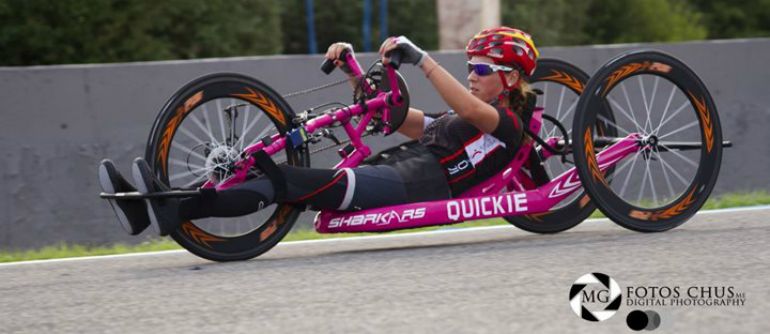Share:
Take it offline!
This Education in Motion resource is also available as a printable PDF.
Download PDF
Dedication, commitment, enthusiasm and competitive spirit are some of the hallmark characteristics associated with the first ever paratriathlon in the last Paralympic Games in Rio 2016.
The first inclusion of this adapted sport in the official program of a Paralympic competition was a recognition of the efforts and achievements of hundreds of athletes all over the world who have been practising the sport for years.

Paratriathlon at the Rio 2016 Games
Paratriathlon is a variant of the triathlon for people with disabilities. It is a sport that combines different sporting disciplines into a single competition, thus requiring a high degree of fitness and preparation in order to compete.
Given that this is a sport that can be practised by people with various physical and sensory disabilities, it means that the paratriathlon allows the use of wheelchairs, tricycles, bicycles, tandem, hand bikes, prostheses and even aides or guides, depending on the category and stage of the competition.
The three sports combined in the paratriathlon are the same as those in conventional triathlon (swimming, cycling and running). At its debut at the Paralympic Games in Rio de Janeiro in 2016, the paratriathlon competition consisted of three sections:
- 750 metres swimming
- 20 kilometres cycling
- 5 kilometre running race
Owing to the short distances, the paratriathlon is also known as the sprint triathlon. The first in Rio was made up of both men's and women's events, each with three categories. (For men PT1, PT2 and PT4 and for women PT2, PT4 and PT5).
How are the different categories of paratriathlon decided on?
The ITU (International Triathlon Union) is responsible for establishing the different categories of paratriathlon according to a ‘Profiles System’, with the objective of including all known disabilities in such a way that it remains fair and balanced for all competing athletes.
However, despite being a very open adapted sport, there are still some who are unable to actively participate in competition level paratriathlons due to the fact that they do not fit into the profiles drawn up by the ITU.
The ITU classification system for paratriathlon sets out a score of 0 to 5 in three different ranges (strength, mobility and neurosensory coordination) with 0 being the lowest measure of each range and 5 being the highest.
The final score of the tests are displayed as six different digits that correspond to the left arm, neck, right arm, left leg, torso and right leg respectively, so as to classify the main disability in relation to which area of the body it affects. The maximum score is 80 for upper limbs, 40 for the neck, 70 for lower limbs and 60 for the torso.
The profiles that make up the six competition categories are then arranged in accordance with these results.

Paratriathlon categories
Although all paratriathlon athletes compete at the same time, each one will do so in such a way as to account for their particular disability. As a general rule, propulsive devices such as fins, flippers or flotation aides are not permitted in the swimming stage, whilst in the cycling stage bicycles of any kind must always be propelled by the rider, either by arms or legs exclusively, rather than using a combination of both.
Conversely, any vehicle and/or prosthesis used in the competition must comply with regulations and standards in order to ensure a fair level of competition for all athletes.
PT 1. Wheelchair users, paraplegics, quadriplegics and competitors with post-polio syndrome.
Competitors with disabilities that prevent the safe use of a conventional bicycle also fall into this category. In the swimming stage, these paratriathlon athletes must enter the water after the rest of the athletes have taken their positions. They will use a handbike during the cycling stage and a wheelchair for the running stage.
PT 2. Athletes with severe disabilities of the lower extremities.
Members of this paratriathlon category will use a bicycle in the cycling section and amputee athletes will be allowed to run and cycle with knee prosthesis or crutches in the running and cycling race stage.
PT 3. Athletes affected by multiple sclerosis, muscular dystrophy, cerebral palsy, double leg amputation or paralysis in multiple extremities.
Athletes in the TRI 3 category must ride a bike or tricycle and run assisted by prosthetics and orthotics if required.

PT 4. Athletes with disabilities of the arms.
Disabilities due to paralysis, amputation above and below the elbow and impediment in both upper extremities. These athletes will be able to use prostheses, harnesses or a ‘sling’ on the bicycle if it allows them to compete more safely.
PT 5. Athletes with disabilities involving minor leg impairments.
Including amputations below the knee. Athletes will ride a conventional bike that is adapted slightly in accordance with ITU regulations and will run with the aid of prosthesis
PT 6. Athletes with visual impairments.
This category applies specifically to visual impairments with acuity of less than 6/60 or a visual field of less than 40 ° with optimal correction. It is compulsory for these athletes to be accompanied by a guide of the same sex throughout the whole competition.
Here at Sunrise Medical we stock a range of sports whelechairs for recreational and competitive use. And if you're more of a specatotor, we have a fantastic range of manual wheelchairs, powered wheelchairs and scooters too!